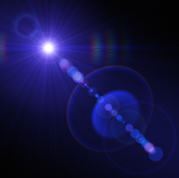May 2011
Spotlight Summary by Taek Yong Hwang
Self-organized 2D periodic arrays of nanostructures in silicon by nanosecond laser irradiation
In this paper, the authors find that a 2-D periodic array of nanoprotrusions can be formed on Si with direct exposure to randomly polarized nanosecond laser pulses at a wavelength of 1064 and 532 nm in a vacuum chamber. The period of this array is determined by the wavelength of the laser beam, and the height and width of each nanoprotrusion are approximately 500 and 100 nm, respectively. Since the authors use a natural consequence of the interaction between nanosecond laser pulses and Si, the fabrication procedure of a 2-D periodic array of nanoprotrusions is significantly simplified, so that additional preparations suggested by previous studies are not required before laser beam irradiation.
The authors show that the formation of a 2-D periodic array of nanoprotrusions is affected not only by the fluence and number of laser pulses but also by the location of the structures on a Si wafer. With higher laser fluence and more pulse irradiation, ablated nanoparticles are only observed in the central region of the laser beam spot instead of forming a 2-D periodic array structure. Moreover, under identical experimental conditions, the area of laser-induced structures depends on the location of laser beam irradiation on a Si wafer. The structured area tends to decrease toward the center of the Si wafer where heat dissipation is faster than at its edge. These observations indicate that appropriate heat dissipation on the Si surface following laser pulse irradiation is necessary to form the 2-D periodic array structures. When heat dissipation is slower, the structures are wiped out before the surface’s resolidification, and the surface cannot reach the temperature required for the formation of the structures for faster heat dissipation.
At the end of this paper, the authors briefly discuss the possible formation mechanism of a 2-D periodic array of nanoprotrusions. Since the period of their 2-D periodic structures is nearly the same as the wavelength of light, the authors believe that the periodic energy deposition due to the interference between the incident and the diffracted light may play an important role in forming their 2-D structures. The periodic energy deposition produces a 2-D periodic distribution of surface temperature, resulting in a surface tension gradient, known as the Marangoni effect. The force due to the gradient of surface tension will induce mass transfer toward the regions that have larger surface tension, and this mass transfer in a periodic fashion eventually leads to the formation of a 2-D periodic array of nanoprotrusions.
Overall, a simple but novel method to fabricate a 2-D periodic array of nanoprotrusions on Si is introduced by the authors. As the authors note, this unique type of 2-D laser-induced structure could have potential applications to optical elements and sensors.
Add Comment
You must log in to add comments.


Article Information
Self-organized 2D periodic arrays of nanostructures in silicon by nanosecond laser irradiation
Barada K. Nayak, Keye Sun, Christian Rothenbach, and Mool C. Gupta
Appl. Opt. 50(16) 2349-2355 (2011) View: HTML | PDF